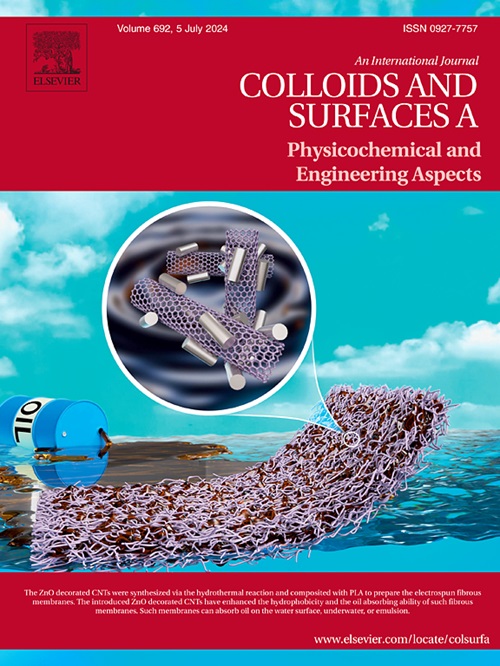Sustainable facet engineering of MIL-125 via ligand control for enhanced solar-driven CO2 reduction
IF 5.4
2区 化学
Q2 CHEMISTRY, PHYSICAL
Colloids and Surfaces A: Physicochemical and Engineering Aspects
Pub Date : 2025-07-17
DOI:10.1016/j.colsurfa.2025.137764
引用次数: 0
Abstract
Developing sustainable photocatalysts for efficient solar-driven CO2 reduction is critical for addressing global carbon emissions and advancing clean energy technologies. Herein, we present a ligand-controlled facet engineering strategy to optimize the morphology and catalytic performance of MIL-125, a titanium-based metal-organic frameworks (MOFs). By systematically tuning the molar ratio of terephthalic acid (H2BDC) to tetrabutyl titanate (TBOT), we achieved selective exposure of high-energy {110} crystal facets and enhanced formation of surface defects, including Ti3 + sites and oxygen vacancies. These features synergistically improved light absorption, charge separation, and CO2 activation. The optimized sample, MIL-125–4 (H2BDC/TBOT = 4:1), exhibited a maximum CO production rate of 34.51 μmol·g−1·h−1 with 98.68 % selectivity under simulated sunlight, outperforming all other variants. It also maintained 75 % of its initial activity after five photocatalytic cycles and possessed a high specific surface area of 1642.15 m2·g−1. This work offers a sustainable and scalable synthesis route to tailor MOFs crystal facets via intrinsic ligand regulation, providing valuable insights for the rational design of advanced photocatalysts for solar fuel generation.
通过配体控制增强太阳能驱动的二氧化碳减排MIL-125的可持续面工程
开发可持续的光催化剂,以实现太阳能驱动的高效二氧化碳减排,对于解决全球碳排放问题和推进清洁能源技术至关重要。在此,我们提出了一种配体控制的面工程策略来优化MIL-125的形态和催化性能,MIL-125是一种钛基金属有机框架(mof)。通过系统地调整对苯二甲酸(H2BDC)与钛酸四丁酯(TBOT)的摩尔比,我们实现了高能{110}晶体表面的选择性暴露,并增强了表面缺陷的形成,包括Ti3 +位点和氧空位。这些特性协同改善了光吸收、电荷分离和CO2活化。优化后的样品MIL-125-4 (H2BDC/TBOT = 4:1)在模拟阳光下的CO产率最高为34.51 μmol·g−1·h−1,选择性为98.68 %,优于其他所有变体。经过5次光催化循环后,其活性仍保持75% %,比表面积高达1642.15 m2·g−1。本研究提供了一种可持续的、可扩展的合成途径,通过内在配体调节来定制mof晶体面,为合理设计用于太阳能燃料发电的先进光催化剂提供了有价值的见解。
本文章由计算机程序翻译,如有差异,请以英文原文为准。
求助全文
约1分钟内获得全文
求助全文
来源期刊
CiteScore
8.70
自引率
9.60%
发文量
2421
审稿时长
56 days
期刊介绍:
Colloids and Surfaces A: Physicochemical and Engineering Aspects is an international journal devoted to the science underlying applications of colloids and interfacial phenomena.
The journal aims at publishing high quality research papers featuring new materials or new insights into the role of colloid and interface science in (for example) food, energy, minerals processing, pharmaceuticals or the environment.

 求助内容:
求助内容: 应助结果提醒方式:
应助结果提醒方式:


